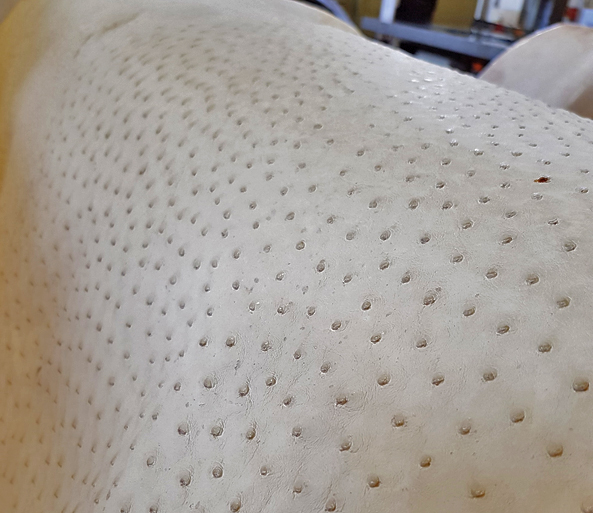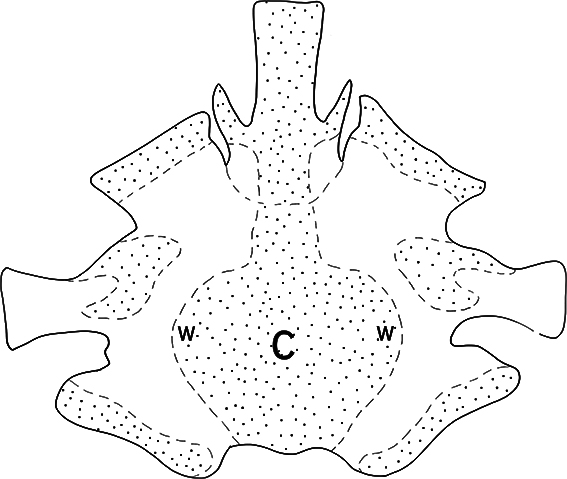There is no doubt that the success of the marketing story of kangaroo lay in that kangaroo had unique strength and structural characteristics, which enticed leather buyers who wanted something different. A similar story can be identified in the success of ostrich leather. The surface characteristic of the bird skin, easily recognisable by the feather follicles (pips) in the crown area of the leather - make it stand out in a sea of boring flat leathers. Finishers trying to emulate that ostrich effect on bovine leathers, through embossing techniques, never seem to get it right. The fake ostrich looks predictable, plastic, and too uniform to be the real thing. Figure 1 shows the iconic surface of ostrich with natural variation, topographical differences, and character.
Figure 1. Surface characteristics of natural ostrich skin.
Surface characteristics
The surface of the ostrich skin makes it more unique than kangaroo or cow leather. A changeable surface can also make it difficult to cut for the final leather article. The surface of the ostrich, seen in Figure 2, show ripping lines which are quite distinct from bovine or ovine leather. The ostrich outline has wings, long legs, and a long neck that must be trimmed to prevent entanglement in the drum.
The most valuable area of the skin, marked with a “C”, in Figure 2, is known as the crown area. The most iconic of the feather follicles, pips, are found in the crown. The major leather article components are cut from this region and the grading of the quality of the skins focusses on this area. The area marked with “W’s”, in Figure 2, are areas that are particularly prone to wrinkling if the mechanical and chemical operations are not done correctly.
Figure 2. Illustrative representation of the dorsal view of an ostrich skin. C= crown, W = area where wrinkles could be seen.
The feather follicular mounds are raised, depending on the age and the method of skin preparation during slaughter. They consist of a follicle, lined by a layer of epidermal cells, that are then ringed by a band of collagen (Lunam and Weir, 2006). The side of the follicular mound that is caudal (opposite side to the ostrich head) contain a cluster of filoplumes (smaller feathers) and hair-like bristles. Between 4 and 5 filoplumes, interspersed with bristles result, upon their removal, in a small set of pinholes that add character to the surface. The raised nature and the pattern on the mound differentiate the ostrich skin from many other leathers, including other ratites.
Cooper (2001) maintains that the average age of slaughter in Zimbabwe is 10 months which yields a skin that is on average 145 dm2 (15.61 ft2). The distribution of the pips on that skin is dependent on the age of the ostrich. The height of the mound is dependent on the genetics of the bird, the age of the animal, the retannage, and liming strategy. A high, full, pip profile results in a bi-layered skin that allows easy two tone effects that are unprecedented across all leather types.
Skin structure
There are many parallels between ostrich skin structure and other leather types. The primary structure of all leathers consists of three dermal layers: the epidermis, the main dermis, and the hypodermis (flesh). In ostrich, like in most birds and reptiles, the epidermis is a thick keratin layer that serves as a protective layer (moisture retention and a barrier for bacterial and harmful penetration). The ostrich epidermis, like in most leather types, is removed during liming and unhairing. Similarly, the flesh layer of the ostrich is cut off during leather manufacture. The removal of the flesh before or after liming is a cause of great debate in the general industry. The fat contained in the flesh is often a cause of fat contamination of the dermis, especially during hot weather. Removal of the flesh before saponification, or emulsifying chemistry is used helps limit the amount of dermal contamination (from the flesh).
The dermis of the ostrich skin has a grain and corium layer like most leathers, however the grain is several cells thick and is considered to be thin and largely cosmetic. Grain separation from the corium is possible in extreme circumstances and like most delamination behaviours depends on a failure of the connective filaments between the two layers. Bacterial attack or alkali/heat hydrolysis are very often the cause of this delamination.
The collagen fibre bundles of the ostrich skin are not as coarse as other leathers, but the material exhibits good resistance to tearing. Lunam and Weir (2006) state the average tear strength in ostrich leather is between 55 and 75 N/mm. These values are very similar to range of values expected to be seen in bovine leather that range from shoe upper to automotive. Kangaroo skin also show values that range from 35 to 140 N/mm which is quite a range, considering that many commentators have said that kangaroo is outstanding in its strength, which it is - except in its lower bands (Looney et al., 2002). The tensile strength of the ostrich is also very comparable to bovine with ostrich strengths ranging from 101 - 249 N/mm2, compared to kangaroo that shows values of between 250 and 400 N/mm2 (Looney et al., 2002; Lunam and Weir, 2006).
The angle of weave of the ostrich is generally lower than other animal types, except for reptiles. The weave is generally horizontal, and this may play quite a large role in its inability to show strength like the kangaroo - but does allow it to hold its own against sheep and cow.
Conclusion
The ostrich may not be able to compete with the tensile strength of the kangaroo, but it certainly holds its own in other physical property areas. The grain thickness and grain surface characteristics are what make the ostrich stand out. Prevention of looseness and the ability to use the natural topography of the leather makes ostrich unique. The weave pattern of the skin and its durability make it histologically, and during wear, a hardy, unique material that oozes luxury and status will combining strength and character.
References
Cooper, R.G. (2001) Ostrich (Struthio camelus var.domesticus) skin and leather: a review focused on southern Africa. World Poultry Sci. J. 57: 157-178.
Lunam, C.A. and Weir, K.A. (2006) Storage of ostrich skin: effects of preservation methods on skin structure, physical properties and microbial flora. A report for the Rural Industries Research and Development Corporation, Australian Government. RIRDC Publication No 06/054: 1-71.
Looney, M., Kyratzis, I., Truong, Y., and Wassenburg, J. (2002) Enhancing the unique properties of kangaroo leather. A report for the Rural Industries Research and Development Corporation, Australian Government. RIRDC Publication No 02/105: 1-71.
Extract from S&V African Leather Magazine Vol12 No6 June 2018 made by H. Procter









